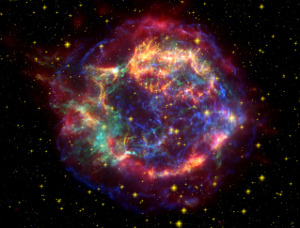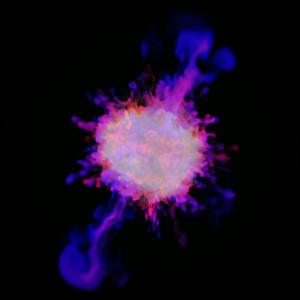|
|  |
Stars with more than eight to ten times the mass of our Sun end their
lives in a gigantic explosion, in which the stellar gas is expelled
into the surrounding space with enormous power. Such supernovae belong
to the most energetic and brightest phenomena in the universe and can
outshine a whole galaxy for weeks. They are the cosmic origin of
chemical elements like carbon, oxygen, silicon, and iron, of which the
Earth and our bodies are made of, and which are bred in massive stars
over millions of years or freshly fused in the stellar explosion.
What, however, causes the disruption of the star? How can the
implosion of the stellar core be reversed to an explosion?
Unfortunately (or luckily!) the processes in the centre of exploding
stars cannot be reproduced in the laboratory, and many solar masses of
intransparent stellar gas obscure our view into the deep interior of
supernovae. Research is therefore strongly dependent on most
sophisticated and challenging computer simulations, in which the
complex mathematical equations are solved that describe the motion of
the stellar gas and the physical processes that occur at the extreme
conditions in the collapsing stellar core. For this task the most
powerful existing supercomputers are used, but still it has been
possible to conduct such calculations only with radical and crude
simplifications until recently.
With the new funding for the project "Modeling Stellar Collapse and
Explosion: Evolving Progenitor Stars to Supernova Remnants", the
scientists will now be able to develop detailed computer models to
understand the processes in collapsing stars in all three spatial
dimensions. This ambitious project aims to obtain more reliable
predictions of both the chemical elements that are produced in
supernova explosions and the neutrino and gravitational wave signals
from future galactic supernovae. Moreover, the theoretical models will
help astronomers to interpret observations of the many detailed
properties in nearby, gaseous and compact remnants of past supernova
explosions. In return, this will allow conclusions to be drawn on the
still incompletely understood internal processes that triggered the
explosions of the stars.
The ERC funding will support the project for five years with up to 2.9
million Euros. According to the ERC, the projects to be funded should
aim high, both with regards to the ambition of the envisaged
scientific achievements as well as to the creativity and originality
of proposed approaches. Peer reviewers evaluate all proposals and rank
the projects; only the highest ranked proposals are then offered an
ERC grant.
The supernova project came out on top among more than 2000 proposals and
will thus receive
attractive, long-term funding, which
is only awarded to active researchers who have a track-record of
significant research achievements in the last 10 years.
Links:
 MPG about Advanced Grants 2012 MPG about Advanced Grants 2012
 ERC Advanced Grants ERC Advanced Grants
 Press Release by the EU Press Release by the EU
|




